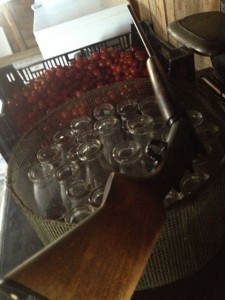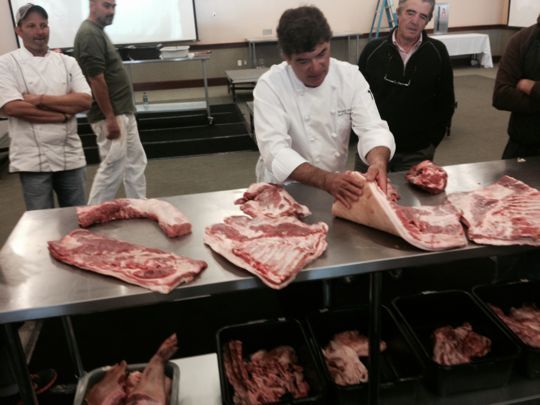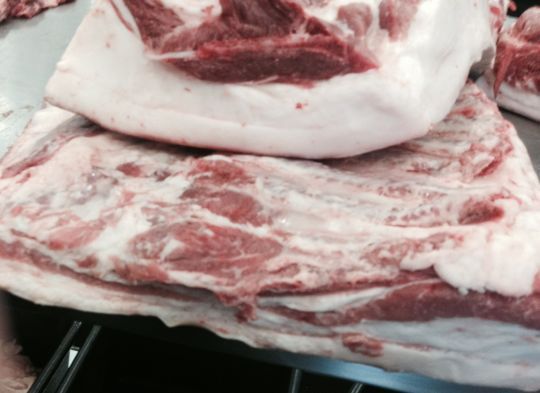Michael Ruhlman's Blog, page 34
October 31, 2013
Highlights from Pigstock TC

Organs and viscera removed. Christoph cuts through the center of the spine with saw and cleaver. (I took all the photos and the video below.)
Christoph Wiesner, the Austrian butcher who raises Mangalitsa, is always tense before the kill. Last year, he told me, yes, he was nervous because it wasn’t his pig, the pig didn’t know him, he couldn’t know what the pig would do. Under normal circumstances the pigs have spent their lives with him and the week before they are done in, he brings the captive bolt, the stunning device, into pens so the pigs are used to even that. The pigs are calm throughout. This year, at Pigstock in Traverse City, MI, Christoph was not only unfamiliar to the pig, he was miked so that his every word echoed through speakers. Furthermore our crowd gathered around to witness the kill. Our Mangalitsa was clearly thinking “This can’t be good.” But it was over quickly (the full video is at the end of this post, along with Christoph’s careful and descriptive evisceration; if you need to know how, here it is).
A half hour after cleanly stunning the pig, with the pig on the table scraped of all its wooly fur, Christoph showed signs of ease. His clenched jaw and uneasy eyes were gone. He smiled and said, “The stun was good, the stick was good, the hair is off. Now, I am happy.”
No small thing to kill another animal, one that weighs more than you, no less. His stick was perfect—”you learn by doing,” he said—this was clear when he split the hog. He showed us where the bolt had penetrated the skull into the brain (not much there, by the way, each lobe about the size of an apricot). The muscle showed no sign of stress, and the organs were evidence that the pig had been well tended and was healthy.
Would that more chefs had access to this kind of experience because, for those who cook and serve and eat meat, it encourages careful and thoughtful treatment of our animals, of all our food. Thank you Christoph and Isabel, and Chip Hoagland and his team for organizing Pigstock yet again.
Two things I came away with this time was how well the Mangalitsa, which is out of favor with chefs here due to the overabundance of fat, can be used when broken down properly (Christoph removed each rib individually, to preserve the meat between the ribs, for example). A restaurant wouldn’t want to only bring in Mangalitsa, but they could be a useful part of a larger pork program. Also, I was reminded of the importance of practice, of doing the same thing over and over, when I watched Polcyn work; he has become a masterful butcher since I first met him in 1997.
I truly hope that readers here will seek out their local farmers for humanely raised and killed and thoughtfully butchered meat.
Below are pix from a big pig week with my partner in Charcuterie and Salumi, Brian Polcyn, beginning in Stonington, Maine, where Brian lead a two-day pig demo for chefs and food enthusiasts (one chef, bless him, drove up from Philadelphia) to promote a culinary institute on that island.
The Mangalitsa shortly before the kill at Black Star Farms (an extraordinary place, worth visiting if you’re ever in northern Michigan).
Captive bolts, the typical stunning device, cost I was told about $1500. The single pig in Maine was put down with this rifle.
 After removing the liver and examining it for signs of parasites (none), Christoph cut pieces of it for observers to taste. It was warm and only mildly livery, pleasantly succulent and minerally.
After removing the liver and examining it for signs of parasites (none), Christoph cut pieces of it for observers to taste. It was warm and only mildly livery, pleasantly succulent and minerally.
Christoph and Isabel Wiesner, husband and wife farmers since the mid-1990s, when they decided they wanted to grow more of their own food. It’s now how they make a living for themselves and their four children. This is before the kill and they are both nervous.
Fresh pig’s blood makes extraordinary blood sausage. Brian made the best I’ve had in my life in sort of a last-minute demo in Maine.
Brian in Brooksville, Maine, demonstrating both American and Italian hog breakdown. The woman who raised the pig is at the right. She was nearly in tears at the end of the communal meal, grateful for once to be able to share in the cooking and the eating of the animal she had raised with people who treated it with such care.
Christoph talks with the chefs before he demonstrates his method of hog breakdown.
This was a small Mangalitsa, but still, you can see the abundance of fat and relatively scant amount of meat (thus the need for careful butchery).
I posted on this earlier, but the difference between a factory hog and a farm-raised Berkshire-Duroc or Mangalitsa is enormous, as Brian demonstrates here. Notice the paltry belly at left. Now that was a poorly treated pig, and shame on us for it.
Isabel’s footwear.
The Kill
This is a video of the kill. The pig is clearly nervous because of all the people and the scary Austrian with the captive bolt.
The Evisceration, part one
This was a male, so Christoph took care of that part first (it had been removed long ago, but the interior part needed to be separated), then works his way down the pig in a clean evisceration, organ by organ.
The Evisceration, part two
Conclusion of the evisceration (showing the gall bladder, which you can put down your disposal to help remove grease; which is what it does in our personal disposal).
If you liked this post, take a look at these links:
My recent post on Stephanie’s Stiavetti’s & Garrett McCord’s book Melt.
Interesting hobby farm businesses are popping up, such as chicken rentals in Traverse City, MI.
Butcher & Packer is a store that specializes in sausage making products.
© 2013 Michael Ruhlman. Photo © 2013 Donna Turner Ruhlman. All rights reserved.
October 28, 2013
Melt, a Giveaway, and Pumpkin Mac & Cheese

Melt: The Art of Macarni and Cheese by Stephanie Stiavetti & Garrett McCord. Photo by Matt Armendariz.
My friends Stephanie Stiavetti, who writes The Culinary Life blog, and Garrett McCord, who writes the blog Vanilla Garlic, are publishing their very first book, Melt: The Art of Macaroni and Cheese, on that all-but-infallible pairing of pasta and cheese. When they asked me to write the foreword, I groaned. This is exactly the kind of cookbook we don’t need more of, I thought to myself. But then I read it, and thought this is exactly the kind of cookbook we need, this nation that has so readily accepted orange flavoring packets to stir into their food. Stephanie and Garrett attempt to raise this often thoughtlessly prepared dish to its highest possible level by asking us to take more care with it, to use excellent pasta and excellent cheese. This is not only a book filled with excellent info on cheeses and pastas and great recipes (photography is by Matt Armendariz), it’s yet another hopeful example of the way American cooks are raising the quality of the food we eat.
To promote this book, the publisher has sent me three copies to give away. All you have to do is tell me in the comments what your favorite or most exciting version of mac and cheese you’ve ever had and why it was so memorable (include a working email, obviously). Winners will be chosen at random, but I’m genuinely eager to hear what your best mac and cheese was (mine, it should be no surprise, was the lobster mac and cheese at the French Laundry in 1998).
Congrats, Stephanie and Garrett! Melt is terrific!

Pumpkin Stuffed with Fontina, Italian Sausage, and Macaroni
Pumpkin Stuffed with Fontina, Italian Sausage, and Macaroni
1 sugar pumpkin, or other sweet variety (not a carving pumpkin), about 5 pounds
Sea salt
Freshly ground black pepper
1 tablespoon olive oil
¼ pound mild Italian pork sausage
4 ounces elbow macaroni
5 ounces Fontina, cut into ¼-inch cubes
2 ounces Gruyère, cut into ¼-inch cubes
3 scallions, diced
1 teaspoon chopped fresh rosemary
1 teaspoon chopped fresh thyme
1 teaspoon chopped fresh sage
1 cup heavy cream
Fontina is a creamy, woodsy, Alpine-style cheese . There are m any varieties of Fontina, from Swiss to Italian, with some fine specimens even coming out of Wisconsin. Each has its own unique profile, so be sure to taste them all and pick the one that you like best. Regardless of which you choose, you will get a nice semihard texture and subtle mushroomy flavor. It just so happens that Fontina pairs beautifully with the sugary flavors of a good baking pumpkin. This recipe, baked inside the pumpkin—a trick inspired by Dorie Greenspan and Ruth Reichl, both famous for their stuffed-pumpkin recipes (among other things)—simply knocked our socks off with flavor and a stylish yet homey presentation.
Although best with Fontina and a touch of Gruyère, another Alpine favorite, this recipe is flexible and can use whatever cheeses, meats, onions, or extra pasta you have on hand. Feel free to experiment. We particularly like Valley Ford’s Estero Gold or its Highway 1 Fontina, as well as Roth Käse’s MezzaLuna Fontina. If you want to try something radical, a creamy blue cheese like Buttermilk Blue or Cambozola will do nicely too.
Preheat the oven to 350°F/178°C. Cut a circle from the top of the pumpkin at a 45-degree angle, the way you would cut open a pumpkin to make a jack-o’-lantern, and set aside. Scoop out the seeds and strings as best you can. Generously salt and pepper the inside of the pumpkin, pop the top back on it, place it on a rimmed baking dish (since the pumpkin may leak or weep a bit), and bake for 45 minutes.
Meanwhile, heat the olive oil in a sauté pan over medium heat. If the sausages are in their casings, remove the meat and discard the casings. Crumble the sausage meat into small chunks and cook until lightly browned. Remove the sausage from the pan with a slotted spoon and set aside to cool. Discard the drippings, or save for gravy or what have you.
Also while the pumpkin bakes, cook the pasta in a large pot of salted boiling water until al dente. Drain through a colander and rinse with cool water to stop the cooking process.
In a bowl, toss together the Fontina, Gruyère, sausage, pasta, scallions, and herbs. Once the pumpkin is done baking, take it out of the oven and fill it with the macaroni and cheese. Pour the cream over the filling. Place the top back on the pumpkin and bake for 1 hour, taking the top off for the last 15 minutes so the cheese on top of the filling can properly brown. If the top cream still seems a bit too wobbly and liquid, give it another 10 minutes in the oven. The cream may bubble over a bit, which is fine. If the pumpkin splits while baking, as occasionally happens, be thankful you set it in a rimmed baking dish and continue to bake as normal.
Allow the pumpkin to rest for 10 minutes before serving. Be careful moving the dish, as the pumpkin may be fragile. You can serve this dish two ways: Cut it into sections and serve them, or just scoop out the insides with scrapings of the pumpkin flesh for each serving. Either way is just dandy. Salt and pepper to taste.
Serves 4
Wine pairings: white Rhône Valley blends, Viognier, oaky Chardonnay, champagne
Additional pairings for the cheese: apples, toasted walnuts, toasted hazelnuts
If you liked this post, take a look at these links:
My past post on making pasta from scratch
Erin Harris’s guest post on Italian Canederli with Walnut Levain.
Check out the actual geometry of pasta shapes, you will be amazed.
Culture magazine is a publication that focuses on the world of cheese.
© 2013 Michael Ruhlman. Photo © 2013 Donna Turner Ruhlman. All rights reserved.
October 25, 2013
Friday Cocktail Hour: The Sawyer
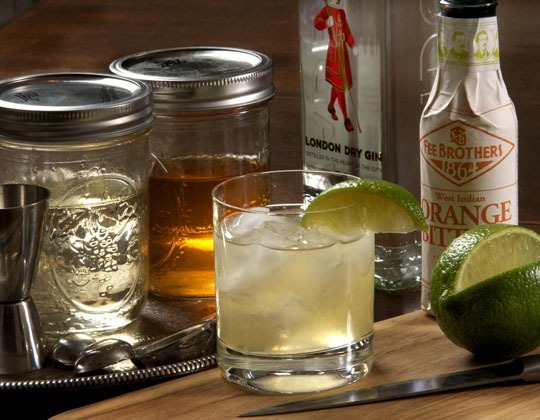
The Sawyer. Photo by Donna Turner Ruhlman
Casting about for a cocktail high in bitters to make use of some of my own personal blend, and one with gin, because that’s what the evening wanted, I happened on this distinctive cocktail, so high in bitters it can clearly fill in for a post-prandial digestif. It was created by Don Lee several years ago at Ssäm Bar in NYC, inspired by Chef Wylie Dufresne, and named for that chef’s daughter. Served to the writer Brad Parsons, it wound up in Parsons’s bitters book.
I love bitters for the complexity they bring to a drink, this one very much in the sour category with its dose of fresh lime juice. It’s become one of my favorite cocktails. If you don’t have citrus bitters (or your own bitters), use what’s on hand. This can be mixed and strained into a chilled coupe, but I like it over rocks. It’s powerful enough to stand up to the steady dilution (if you don’t forget where you set it down, as I did last night in between computer, shooting the shot, and cooking dinner).
The Sawyer
2 ounces gin (60 grams)
1/2 ounce lime juice (15 grams)
1/2 ounce simple syrup (15 grams)
1 teaspoon homemade or other bitters (5 to 7 grams)
1 teaspoon citrus bitters (5 to 7 grams)
lime wedge
Combine all in a lowball glass and fill with ice, garnish with lime.
If you liked this post, take a look at these links:
My cocktail posts that use gin: Hasty Negroni and Tom Collins.
A popular line of spirits is making its way out of Door County, Wisconsin—check out Death’s Door Spirits.
Learn how to make your own gin at home.
© 2013 Michael Ruhlman. Photo © 2013 Donna Turner Ruhlman. All rights reserved.
October 24, 2013
Heritage Versus Commercial Hogs
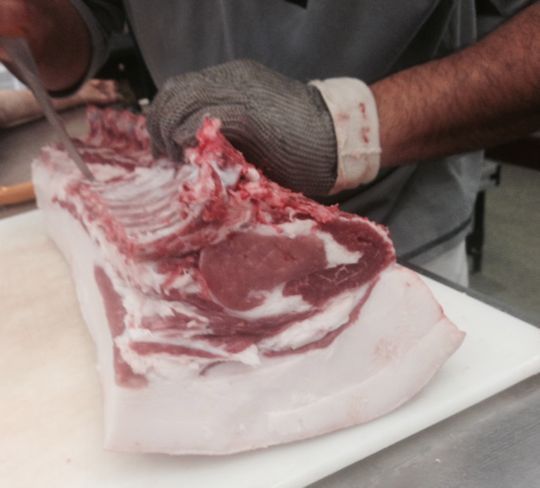
The loin and backfat of a small Mangalitsa hog.
Wrapping up three great days of Pigstock in Traverse City, MI, and I’ll write more about it, but had to quickly share the astonishing differences in breeds of hogs, and most important, the difference between a factory-farmed pig and a properly raised pig
Above Brian Polcyn shows four different breeds. On the left is the belly of a factory-farmed pig, breed not known. Notice how diminutive it is, how little fat is on that loin, which I guarantee tastes like cardboard when cooked. Compare it to the one he’s holding up, a farm-raised Berkshire-Duroc mix. When you buy the one on the left, not only will it not be a pleasure to cook and eat, you have cast a vote for more just like it. When you buy a belly from a farm-raised Berkshire, you have cast a vote for more of those.
This is a close-up of the Berkshire belly and loin.
Every one of us impacts the food system each time we put our money down. I know it’s not always possible, for numerous reasons, to buy the very best food for you and your family, but it’s fundamental that you are aware of the impact of your actions and, if you care about the quality of what you and your family eats, the difference between good food and compromised food.
October 21, 2013
Italian Canederli with Walnut Levain
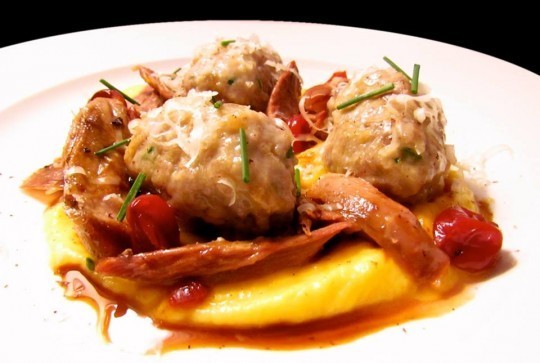
Italian Canederli. Photo by Erin Harris.
I’m in Traverse City, Michigan, at Pigstock 2013. Herewith, a guest post from Chef Erin Harris. Erin began her culinary adventure in her hometown of London, Ontario, where she started cooking in a local fine dining restaurant at the age of 16. Erin studied Culinary Arts at Fanshawe College, and continued her education at George Brown College, where she studied La Cucina Italiana. This diploma course took Erin to Italy for 6 months where she studied Etruscan-era cuisine in Tuscany, and regional specialties in Trentino-Alto Adige. Erin found her true love while in Europe: cheese. She now owns a small boutique cheese shop in a local farmers’ market—The Cheese Poet—where she sells all of the best Canadian-made cheeses and charcuterie. Erin is also a sales consultant for a respected national wine agency, and teaches cooking classes in her free time. —MR
By Chef Erin Harris
Trento, Italy, is situated at the base of the Dolomite mountains, near the Austrian and Swiss borders. In 2004, while completing a stage at Osteria a le Due Spade in Trento, I had the great fortune to learn about canederli, a regional specialty of Trentino-Alto Adige. Chef Federico Parolari introduced me to this regional Italian cuisine that shares many similarities with its neighbors to the north. These bread dumplings, also known as knödel, are nothing more than a use for day-old bread—but for me, nothing less than a beautiful memory of a place and time in my culinary journey. Canederli are excellent on their own, as a side dish to braised meats, or as part of a composed dish like the one pictured here with duck confit, butternut squash puree, picked sour cherries, and duck jus. This recipe for canederli calls for walnut levain, a rich walnut sourdough bread. I find the sourdough elevates the flavor profile of these dumplings, while the walnuts give them an enjoyable texture. The canederli are traditionally made with rustic Italian style country bread.
Italian Canederli with Walnut Levain
2 ounces speck
3 tablespoons extra-virgin olive oil
1 medium onion, finely chopped
3 cups walnut levain, day-old, crusts removed, cut in 1-inch cubes
1 cup white bread, day-old, crusts removed, cut in 1-inch cubes
2 cups milk
1 cup Grana Padano or Parmigiano-Reggiano, plus more for topping
1⁄4 cup fresh chives, chopped
2 tablespoons Italian parsley, chopped
2 tablespoons fresh marjoram, chopped (omit if unable to find)
1⁄2 teaspoon kosher or sea salt, plus 1 tablespoon for the water
Freshly ground black pepper to taste
3 eggs, beaten with a pinch of salt
1 cup all-purpose flour
2 cups dry white wine, good enough to drink
3⁄4 cup cold unsalted butter
First, cut the speck into strips about 1/3 inch wide; chop the strips crosswise to form little square bits of meat.
Pour the olive oil into a small skillet, and set it over medium heat. Stir in the onion, and cook until it starts sizzling. Spoon a tablespoon or two of water into the pan (so the onions soften without coloring), and cook for 3 or 4 minutes more. Scatter in the minced speck and cook for 2 or 3 minutes, until it has rendered its fat. Scrape the onion and speck into a large bowl and let cool.
Put the bread cubes in another bowl, and pour in the milk. Toss the cubes so they’re all drenched, then let them soak up the milk for about 10 minutes, until completely saturated. By handfuls, squeeze the bread, discarding the excess milk.
Loosen the compressed bread, tearing it into shreds, and toss them into the bowl with the onions and speck. Add the grated cheese, herbs, 1⁄2 teaspoon salt, and pepper, and toss everything together. Pour the beaten eggs over the bread mixture, and stir to blend. Finally, sprinkle in 1/4 cup of the flour and incorporate it to form a moist, sticky dough. Pick up a bit and form it into a ball: if it is too soft to keep a shape, stir in more flour, a tablespoon at a time.
Fill a wide pot with about 6 quarts water, and add the 1 tablespoon salt; bring to a boil. Put the white wine in a big skillet and allow it to simmer, uncovered, until reduced to 2/3 cup. Add the cold butter to the pan and continue to shake the pan until the butter has fully melted and emulsified with the wine reduction. Season with salt and pepper and set aside but keep warm.
Spread 1/2 cup flour on a tray or baking sheet. With floured hands, scoop up a small portion of dough, about 2 tablespoons. Shape the dough into an oval, tossing it from hand to hand, shaping it gently. Lay it in the flour, and roll the oval to coat it all over.
Set in on one side of the tray, and form dumplings from the rest of the dough in the same way. With the poaching water at a steady boil, drop in the dumplings, one at a time but quickly. Handle them gently so they don’t break apart in the water. With the end of a wooden spoon, gently check the bottom of the pot to ensure they are not sticking. Bring the water back to a steady simmer, but do not boil, as this could also break apart the canederli. Let them cook, uncovered, until they have risen to the surface of the water. Simmer them for another minute to ensure they are fully cooked, and test one dumpling before finishing the dish. They should no longer be wet in the center.
To finish, lift the dumplings with a slotted spoon, let drain over the pot for a few seconds, and gently place them in the warm wine and butter sauce. Spoon the sauce over the canederli and check the seasoning. Toss the dumplings gently in the pan. Serve them right away on individual plates or a platter, topped with grated Parmigiano-Reggiano or Grana Padano, fresh herbs, and more pepper.
If you are serving them as an accompaniment to braised or roasted meats, you can nap the pan juices over the canederli. You can also arrange the buttered canederli around the meat on a platter, letting them slowly absorb the juices or sauce.
Yield: side dish for 6-8 people
Other links you may like:
My past post on making pasta from scratch.
Stephanie Stiavetti’s pasta rant and her pasta primer.
Visit my friend Kate Hill in Gascony, France, for a culinary retreat.
Eataly, located in NYC and soon to be in Chicago, is a fantastic Italian store and houses mini restaurants.
© 2013 Michael Ruhlman. Photo © 2013 Donna Turner Ruhlman. All rights reserved.
October 18, 2013
Friday Cocktail Hour: The Traverse City Zinger Returns

The TC Zinger. Photo by Donna Turner Ruhlman.
I’m presumably in Stonington, Maine, cutting pig and rejoicing in the glories of the hog with Charcuterie pal and co-author Brian Polcyn, to benefit the Island Culinary & Ecological Center. (Join us if you’re anywhere near Stonington! Details here.) From Maine we return to wonderful Traverse City and Pigstock, so I’m reposting this splendid cocktail made from gin and preserved Michigan cherries (don’t have any on hand? improvise!—a gin sour with preserved fruit). —MR
A PR firm sent me a bottle of Nolet’s gin, which I was happy to taste (and used in The Southside), but when I was researching the gin I came across a Cocktail Enthusiast review of the gin, and lo! What’s this? The author of the post, Kevin Gray, included a cocktail recipe pairing the gin with sour cherries. His post calls it a Nolet’s New Fashioned. (I don’t think any general drink name should be brand specific, unless it came from the company, which this one did—shame on you Kevin! Have a little imagination, or steal, like I do!)
Gray’s post accurately reviews the qualities of Nolet’s; it is indeed superlative gin. Slightly more floral than my beloved Beefeater, but still very dry. It’s so good, in fact, that arguably it should be saved exclusively for martinis. Honestly. If it sucked I wouldn’t drink it or write about it. But, hey, I’ll drink Barton‘s, so that’s who you’re dealing with here.
I recently returned from Traverse City, MI, tart cherry capital of the country (Michigan grows 70% of the total U.S. harvest, I was told), and in my Pigstock swag bag was a jar of local cherry preserves. As I’d bought some Michigan grappa and pear brandy (happily, Brian and I managed not to polish off the entire bottle that night), I was forced to check a bag ($25, thanks Delta, I’ll be flying United next time), so I returned with the preserves as well. And because I’m still so totally jazzed on the whole Pigstock and Northern Michigan experience, I offer this cocktail.
The first of the preserves went on Donna’s morning biscuits, but then they went into this heavenly cocktail: gin, pulverized preserved cherries, and a gingery bitters (Angostura or whatever’s available to you is fine). I do all of my pulverizing in a mortar and pestle; no wimpy “muddling” in this household. Love this cocktail. Thank you, Kevin and Nolet’s, but I’m renaming it.
The Traverse City Zinger
20 grams preserved tart cherries (about 2 teaspoons)
60 grams gin (2 ounces)
5 or 6 dashes bitters
Pulverize the cherries using a mortar and pestle.
Add the gin and bitters to the mortar. Give the drink another stir with the pestle.
Pour into a lowball glass over ice.
Raise your glass to Mother Nature and ask for a good growing season in Northern Michigan next year.
Other links you may like:
Other recent cocktails are: the Derby, the Cobbler, and the Old Fashioned with Homemade Bitters.
Check out these Michigan Wineries: Left Foot Charley, Chateau Chantal, Chateau Grand Traverse, L. Mawby, and Old Mission Peninsula, to name a few.
Make your own sour cherry jam.
© 2013 Michael Ruhlman. Photo © 2013 Donna Turner Ruhlman. All rights reserved.
October 16, 2013
Me and Ina Garten in Pittsburgh

Ina Garten’s minestrone soup. Photo by Donna Turner Ruhlman.
Ina Garten and I had such a good time on stage at Playhouse Square in Cleveland last year, she’s asked me to join her tomorrow for a similar show at the Benedum Center in Pittsburgh (details here). Garten is the brain and heart behind what has become an adored brand. And such is the subject of our talk, business and brands, as well as food and cooking. (Though ask me in the comments field below if there’s something specific you’d like me to address.)
She, like me, is something of an accident—that is, Garten never set out to do what she is doing. She knew by age thirty that she didn’t want to be entombed as a policy wonk in D.C., so she put a low-bid offer on a prepared foods store in the Hamptons and got it. It had a felicitous name, which she kept, and with absolutely no training, she built it into a solid business, eventually branching out into catering. In 1996, after eighteen years, she was ready to move on.
More or less as something to fill the hours while she figured out what the hell she was going to do for the rest of her life—she was pushing fifty, after all, time to get a move on for part II, the stock market, another business, perhaps—she wrote a cookbook. And she sold it to Clarkson Potter. Her store had been in the Hamptons, not Kansas, and powerful people, charmed by her warmth and savvy, had befriended her. But even an intro to the book by Martha Stewart didn’t merit a first run of 10,000 copies. The deal was good only if she agreed to buy half that number to sell at her store.
What did she do? She went the publisher one better, investing heavily in the book on photography, styling, and publicity. The 1999 book became a bestseller and Ina went from well known in the Hamptons to well known throughout the country.
A television show followed, though not without her initial resistance. But once it aired it was so honest, so lacking in the phony good cheer and bullshit that all but defined the dump-and-stir shows of the last decade, even cynical chefs and Food Network trashers embraced it and her.
All of which is why I’m so eager to rejoin her again tomorrow.
I’d been wanting to make a minestrone for a while after my sister-in-law made one over the Thanksgiving weekend, and perusing Ina Garten’s new book, Barefoot Contessa Foolproof, in anticipation of tomorrow night, lo and behold! Done. And yep, it’s solid and delicious. Takes a few minutes of chopping, but it comes together in a flash. Be organized, and dinner’s ready in a half hour. (Though I do say I worry about the book’s commercial prospects, only 315 five-star reviews on Amazon….)
I say it all the time and I know Ina joins me: Cook your own food.
Winter Minestrone and Garlic Bruschetta
Good olive oil
4 ounces pancetta, ½-inch-diced
1½ cups chopped yellow onions
2 cups (½-inch-diced) carrots (3 carrots)
2 cups (½-inch-diced) celery (3 stalks)
2½ cups (½-inch-diced) peeled butternut squash
1½ tablespoons minced garlic (4 cloves)
2 teaspoons chopped fresh thyme leaves
1 (26-ounce) can or box diced tomatoes, such as Pomi
6 to 8 cups chicken stock, preferably homemade
1 bay leaf
Kosher salt and freshly ground black pepper
1 (15-ounce) can cannellini beans, drained and rinsed
2 cups cooked small pasta, such as tubetti
8 to 10 ounces fresh baby spinach leaves
½ cup good dry white wine
2 tablespoons store-bought pesto
Freshly grated Parmesan cheese, for serving
Garlic Bruschetta (recipe follows)
Heat 2 tablespoons of olive oil over medium heat in a large, heavy pot or Dutch oven. Add the pancetta and cook over medium-low heat for 6 to 8 minutes, stirring occasionally, until lightly browned. Add the onions, carrots, celery, squash, garlic, and thyme and cook over medium heat, stirring occasionally, for 8 to 10 minutes, until the vegetables begin to soften.
Add the tomatoes, 6 cups of the chicken stock, the bay leaf, 1 tablespoon salt, and 1½ teaspoons pepper to the pot. Bring to a boil, then lower the heat and simmer uncovered for 30 minutes, until the vegetables are tender.
Discard the bay leaf. Add the beans and cooked pasta and heat through. The soup should be quite thick but if it’s too thick, I add more chicken stock. Just before serving, reheat the soup, add the spinach, and toss with 2 big spoons (like tossing a salad). Cook just until the leaves are wilted. Stir in the white wine and pesto. Depending on the saltiness of the chicken stock, add another teaspoon or two of salt to taste. Serve large shallow bowls of soup with bruschetta on top. Sprinkle with Parmesan cheese, drizzle with olive oil, and serve hot.
Serves 6 to 8
Garlic Bruschetta
1 French baguette
Good olive oil
1 clove garlic, cut in half lengthwise
Preheat the oven to 425°F/218°C.
Slice the baguette at a 45 degree angle in ½-inch-thick slices. Brush both sides of the bread with olive oil and bake for 6 minutes, until lightly toasted. Take the slices out of the oven and rub the surface of each one with the cut clove of garlic.
Copyright 2012, Barefoot Contessa Foolproof, All Rights Reserved
Check out these other links:
See more recipes from Ina on the Food Network website.
An interesting article about Ina building her house in the Hamptons.
Take a peek into my considerably more modest online store.
© 2013 Michael Ruhlman. Photo © 2013 Donna Turner Ruhlman. All rights reserved.
October 14, 2013
October 11, 2013
Friday Cocktail: The Old-Fashionedw/Homemade Bitters
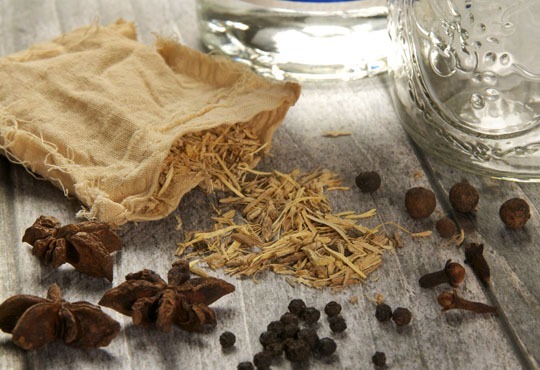
Ingredients for homemade bitters: the woody shreds are Angelica root, the bitter component, along with aromatics, star anise, pepper, cloves, allspice. Photos by Donna Turner Ruhlman
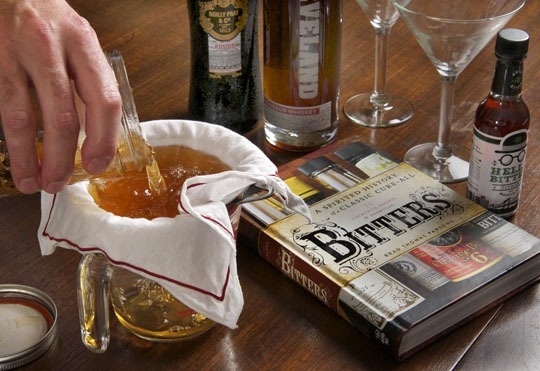
Straining bitters after 1 month’s maceration. Photos by Donna Turner Ruhlman.
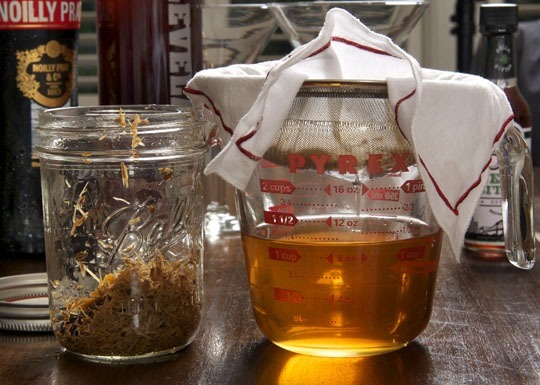
Bitters, strained.
I love bitters for the complexity they bring to any drink, or situation in life for that matter, and I use them with a heavy hand in cocktails. One of my favorite cocktails is the Old-Fashioned (see below), so simple, so satisfying: whiskey, sugar, bitters.
But what exactly are bitters? You don’t really know until you make some yourself.
Bitters are simply flavor extractions. Happily, our neighbor Tobin Ludwig is one of the founders of Hella Bitters, which makes a variety of splendid bitters (about 1500 bottles a month), and he gave me a quick lesson in their making.
“I totally encourage people to make their own bitters at home,” Tobin told me this summer. “It’s a fun experiment.”
There is a single key to bitters: the bittering agent itself, most commonly angelica root or gentian root. The rest is primarily flavoring. To extract the bitterness, you need alcohol. The flavorings can be any you wish, the alcohol any you wish. But Tobin started me out simply. Use a high-proof vodka, 110 proof, cut with water by 50%. Combine the above ingredients (angelica root he gave to me, pictured above, in a cool little sack; star anise, pepper, clove, allspice; other common spices are cinnamon, orange peel, and cardamom) with the alcohol and water in a mason jar for one month, shaking it every now and then. Strain it through cloth. That’s it. Your own personalized bitters.
You can buy angelica and gentian root from the Dandelion Botanical Company. Or search Google; there many sources. The rest of the flavorings can be found in grocery stores. Use the freshest you can find—that is, if you don’t remember how long ago you bought the allspice sitting in your spice rack, best to get some fresh.
If you want some great bitters recipes from an expert (and numerous great cocktails), get Brad Parsons’s book Bitters. It’s a truly lovely volume.
But if the work day is done, have an Old-Fashioned tonight with whatever is on hand, one of the best cocktails there is, thanks to the magical essence called bitters.

The Old-Fashioned. Photo by Donna Turner Ruhlman.
The Old-Fashioned
4 to 6 grams sugar (about a teaspoon)
4 to 6 grams bitters (about a teaspoon)
60 grams bourbon or rye (2 ounces)
Lemon
Place the sugar and bitters in a rocks glass and muddle and stir to get the sugar dissolving.
Add the bourbon or rye and stir.
Add ice and a squeeze of lemon (or a twist or orange zest).
If you liked this post, take a look at these links:
My cocktail posts that use bitters: the Berkshire Martinez, the Perfect Manhattan, and, of course, the Rum Old-Fashioned.
Watch the History of Whiskey from the History Channel.
The Five O’Clock Cocktail Blog is written and shaken by Rose Maura Lorre.
My favorite bar in Cleveland is the Velvet Tango Room.
© 2013 Michael Ruhlman. Photo © 2013 Donna Turner Ruhlman. All rights reserved.
Michael Ruhlman's Blog
- Michael Ruhlman's profile
- 354 followers



